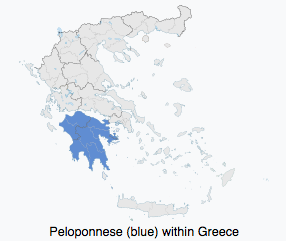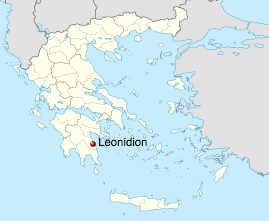
According to Yvonne Hunt, in her definitive book on Greek dance Traditional Dance in Greek Culture, “the southern tip of the Balkan Penninsula derives its name from ancient times when it was known as Pelop’s Island (nisos). [Pelops was a mythical figure said to have conquered the entire region – DB]. It is also frequently referred to by its medieval name, the Moreá. This region of Greece is resplendent with scenic grandeur, ancient history, and marvelous archeological sites.”

The history of Greece can be said to have been born and reborn in the Peloponnese. It contains such legendary cities as Corinth and Sparta, though today its largest cities are Pátra (170,000) and Kalamáta (55,000).

Greece begins with Mycenae, 1600 BC – 1100 BC
Although fire-building hunter-gatherers had been living in Greece for maybe 500,000 years, the last Ice Age seems to have wiped them out. When the glaciers receeded, people started moving in from Anatolia and Europe, roughly 4000 years ago. Historians credit the beginnings of Greece to the beginnings of the Greek language – an adaptation of a writing system found earlier on Crete (dubbed Linear A). Written evidence of this early Greek (dubbed Linear B), started appearing around 1600 BC in the military stronghold of Mycenae (see map above).

The culture uncovered in this archaeological site was representative of other sites throughout the Peloponnese, collectively known as the Mycenaeans. The time period between 1600 BC to 1100BC became known as the Mycenaean Age. The Mycenaean civilization, mainland Greece’s (and Europe’s) first major civilization, dominated the Peloponnese in the Bronze Age. For some unknown reason (there are MANY theories) Mycenaean civilization collapsed and the region entered a Dark Age about which very little is known. When writing appears again, roughly 700 BC, it is attributed to Homer, and the stories of Homer describe the legends and heroes of Mycenaean Greece.
Olympia, Corinth, Sparta, Alexander, Rome, 776 BC – 400
According to Wikipedia: “In 776 BC, the first Olympic Games were held at Olympia, in the western Peloponnese and this date is sometimes used to denote the beginning of the classical period of Greek antiquity. During classical antiquity, the Peloponnese was at the heart of the affairs of ancient Greece. It possessed some of Greece’s most powerful city-states, and was the location of some of its bloodiest battles.
The major cities of Sparta, Corinth, Argos and Megalopolis were all located on the Peloponnese, and it was the centre of the Peloponnesian League. Soldiers from the peninsula fought in the Persian Wars, and it was also the scene of the Peloponnesian War of 431–404 BC. The entire Peloponnese with the notable exception of Sparta joined Alexander’s expedition against the Persian Empire.
Along with the rest of Greece, the Peloponnese fell to the expanding Roman Republic in 146 BC, when the Romans razed the city of Corinth and massacred its inhabitants. They created the province of Achaea comprising the Peloponnese and central Greece. During the Roman period, the peninsula remained prosperous but became a power backwater, relatively cut off from the affairs of the wider Roman world.”
A Slavic invasion?
In a theory hotly debated by scholars for over 170 years, the German historian Jacob Philipp Fallmerayer proposed that the medieval Peloponneseans were totally extinguished by Slavic and Avar invaders and replaced by Slavic settlers during the 6th century CE. Although Slavic peoples at one thime occupied much territory in the Pelolponnese, a genetic analysis published in 2017, found here https://www.nature.com/articles/ejhg201718 came to this conclusion: “By principal component analysis (PCA) and ADMIXTURE analysis the Peloponneseans are clearly distinguishable from the populations of the Slavic homeland and are very similar to Sicilians and Italians. Using a novel method of quantitative analysis of ADMIXTURE output we find that the Slavic ancestry of Peloponnesean subpopulations ranges from 0.2 to 14.4%. Subpopulations considered by Fallmerayer to be Slavic tribes or to have Near Eastern origin, have no significant ancestry of either. This study rejects the theory of extinction of medieval Peloponneseans and illustrates how genetics can clarify important aspects of the history of a human population.”
Byzantium, the Franks, Moreá, Arvanites; 400 – 1460
Byzantium is a word used by English-speaking historians to describe the Eastern Roman Empire. By the 3rd century, Western Europe was becoming overrun by ‘barbarians’ [barbarian comes from a Greek word meaning “people who don’t speak Greek”]. In 330 the Emperor Constantine I moved the capital of the Empire from Rome to the Greek city of Byzantium, renaming it after himself – Constantinople. It was a smart move: as Rome became less secure, the location of Constantinople helped it stay rich and strong.
Byzantium survived the fragmentation and fall of the Western Roman Empire in the 5th century AD and continued to exist for an additional thousand years until it fell to the Ottoman Empire in 1453. During most of its existence, the empire was the most powerful economic, cultural, and military force in Europe.
In the Peloponese, Byzantine control fluctuated according to its internal strength and that of foreign invaders – Avars, Slavs, Arabs, Venetians, Western Europeans, (collectively known by the Greeks as ‘Franks’), and, finally and most devastatingly, the Ottoman Turks. The Byzantine Empire was delivered a mortal blow during the Fourth Crusade, when Constantinople was sacked in 1204 by Western “Crusader” adventurers, and the territories that the empire formerly governed were divided into competing Byzantine Greek and Latin realms.
The Peloponnese was one of those regions dominated alternately by Greek (Byzantine, Orthodox) and Latin (‘Frank’, Catholic) powers. In 1259, the Byzantines reclaimed parts of the Peloponnese, renaming it the Despotate Morea. Traditionally, scholars thought the name to have originated from the word moreá (μορέα), meaning morus or mulberry, a tree which, though known in the region from the ancient times, gained value after the 6th century, when mulberry-eating silkworms were smuggled from China to Byzantium.

By 1430 the entire peninsula was again ruled by Byzantines, and called Morea – an name that continued to resurface even after the Ottoman Turks took control in 1460. The Ottoman ‘Eyalet of Morea’ was formed sometime in the mid-17th century, and there was even a Venetian “Kingdom of the Morea” from 1699 – 1715.
The same period was also marked by the migration and settlement of the Arvanites to Central Greece and the Peloponnese. Arvanites in Greece originated from Albanian settlers who moved south from areas in what is today southern Albania during the late middle ages. The reasons for this migration are not entirely clear and may be manifold. In many instances the Arvanites were invited by the Byzantine and Latin rulers of the time. They were employed to re-settle areas that had been largely depopulated through wars, epidemics, and other reasons, and they were employed as soldiers.
During the Greek War of Independence, many Arvanites played an important role fighting on the Greek side against the Ottomans, often as national Greek heroes. With the formation of modern nations and nation-states in the Balkans, Arvanites have come to be regarded as an integral part of the Greek nation.
The Revolution – Greece is reborn, 1821 – 1832
From Culture and Customs of Greece by Artemis Leontis, 2009. “The Greek revolution of 1821 found its inspiration in the desire to overthrow an alien, oppressive ruler and in two other sources: nationalism, on the one hand (the belief that people sharing the Greek language and culture constitute a group and have the right to self-determination) and philhellenism (the idea that the world owes Greeks their independence in return for rich legacies received from their ancient ancestors)….In 1814 the secret Filiki Etairia (Friendly Society) formed to organize the war with financial backing from wealthy Greek merchants….They siezed the opportunity when Ottoman armed forces were tied up fighting Ali Pasha, the Ottoman governor of mainland Greece. The revolution’s beginning in 1821 is commemorated each year on March 25, the feast day of the Annunciation, which also carries the message of divine salvation. Legend has it that Bishop Germanos raised the flag of revolt at the monastary of Agia Lavra in the Peloponnese on this day. That same month, Alexandros Ypsilantis issued a proclamation of revolt in Wallachia (present-day Romania) and led a small rebel group into Turkish territory in hopes that Orthodox Russia would quickly dispatch support for the Greek rebellion, but he found himself abandoned and renounced….The war was bloody, with many civilian casualties on both sides….massacres at Chios (1822), Psara (1824), Kassos (1824), and Messolonghi (1826, and the death of Lord Byron at Messolonghi, gained foreign sympathy for the Greek cause.
Greek rebels achieved early successes and met to form an assembly (January, 1822), but internal fighting broke out among rebel groups. In 1825, Ibrahim Pasha of Egypt….reconquered the Peloponnese for the Ottomans and held it until 1828. The turning point for the rebels came when the Great Powers, Britain, Russia, and France, sent in a joint naval squadron that destroyed the Ottoman fleet in the naval battle of Navarino (October 20, 1827). The Russian army continued to wage war near the Ottoman capital of Constantinople (sic) forcing the Ottomans to make peace.”
The success of the Greek revolution was largely due to the loyalty and ruthlessness of Peloponnesian tribes, including many Arvanites. After victory, these strengths soon became weaknesses. The tribal chiefs were considered backward – only interested in protecting their local powers – a hindrance to forging a unified modern state. The Peloponnese slowly declined from its position of leading power in Greece.
Dances of the Peloponnese
Yvonne Hunt (1995) writes: “In spite of all its historical and archaeological variety the Pelopónnesos is singularly lacking in that same kind of variety dance-wise. Undoubtably there were other dances in the past, just as existed in other parts of the country….What has remained throughout the Pelepónnesos are those dances usually referred to today as “pan-hellenic”, i.e. those performed throughout the entire country. Sta Tria, Tsámikos, Syrtós/Kalamatianós....Another well-known dance of the Pelepónnesos is the Tsakónikos….There are other dances associated with only one or two villages in the Pelepónnesos, such as the Diplós Horós danced in some villages of Arkadia and possibly others performed on specific occasions but which are not mentioned here. This is true of all regions. This overview is intended to be just that and not by any means a complete catalogue of all the dances.”
Sta Tria
For more about Sta Tria, click: https://folkdancefootnotes.org/dance/a-real-folk-dance-what-is-it/about/sta-tria-greece/
Tsámikos
The songs are heard:
To be an olive tree in Salona, song by Christos Kyriakopoulos
Let the plane tree burn, Andriopoulos song
Organic
The old man, song, Eugenia Verra
Down in Valtos the villages, song Andriopoulos
A Levantine was dancing, a song by Kiki Frangouli
Let the plane tree burn, Andriopoulos song
Be like the youth twice, Kotrotsou song

For more on Tsámiko, click: https://folkdancefootnotes.org/dance/a-real-folk-dance-what-is-it/about/tsamikos-transformed/
Syrtós/Kalamatianós
Wikipedia says: “In the 19th century, this dance was called Syrtos O Peloponisios. It is believed to have acquired the name kalamatianos from the town of Kalamata in southern Greece; most Greek dances are commonly named after the villages or areas from which they are considered to have originated.”
Link to YouTube here: https://www.youtube.com/watch?v=N0-IVx2ap84
The caption to the YouTube includes Greek & English lyrics
to the song “OULA TA POULAKIA” – “All the birds”
For more on Kalamatiano, click: https://folkdancefootnotes.org/dance/a-real-folk-dance-what-is-it/about/kalamatiano-syrto-greece/
Tsakónikos

For more on Tsakónikos, click: https://folkdancefootnotes.org/dance/a-real-folk-dance-what-is-it/about/tsakonikos-%cf%84%cf%83%ce%b1%ce%ba%cf%8e%ce%bd%ce%b9%ce%ba%ce%bf%cf%82-and-tsakonia-peloponnese-greece/
